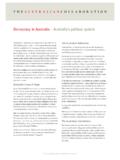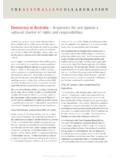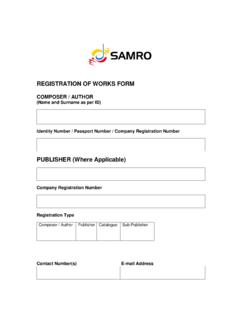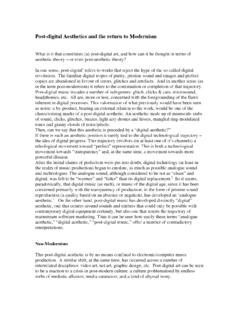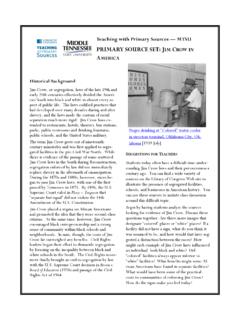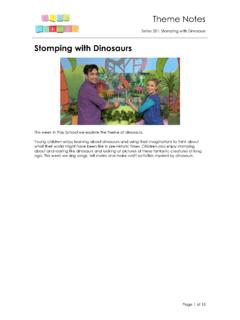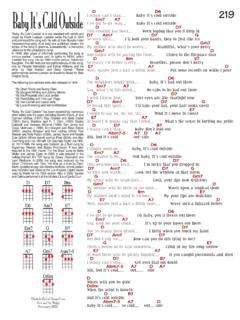Transcription of The Role of the Arts in Australia - Australian …
1 TheAusTrAliAnCollAborATion A Collaboration of National Community arts play a central part in the way we live, the way we think and how we feel about ourselves. Almost eve-rybody in Australia listens to music, reads books, goes to the theatre, concerts or dances, goes to galleries and art museums or is interested in fashion and design. In homes, workplaces, cars and trucks across the country people of all ages enjoy music as part of their daily routine. We love watching films in cinemas, on television and today even on our mobile phones. According to the study Australians and the arts , nine out of ten Australians think it is impor-tant to have some creative skills. The arts are also a great source of pride for Australians.
2 They made a very large contribution to the success of two of the biggest single events in recent Australian history: the Sydney Olympics and the Melbourne Commonwealth Games. The opening and closing ceremonies were artistic events, presenting distinct Australian images to the world. This fact sheet examines the role of the arts in Australian society. It looks at the way the arts shape our lives and the life of the Australian community. Historical backgroundIndigenous Australians, the original inhabitants of the great southern continent, have one of the world s long-est-surviving artistic traditions. Australia has some of the world s oldest rock art dating back more than 20,000 years.
3 Indigenous communities still place great impor-tance on artistic activity as a way of sharing experiences and emotions, teaching, developing communities and sup-porting people with employment. Indigenous arts activ-ity is not only about preserving a time-honoured cultural tradition. Today s Indigenous arts represent a vibrant con-temporary culture. Indigenous artists working in dance, painting, film and music are reaching into the heart of mainstream Australian society, bringing renewed pride to their communities and making a real and practical contri-bution to reconciliation. Films such as Samson and Delilah, Rabbit Proof Fence and Bran Nue Dae have put Indigenous issues into the minds of most Australians.
4 The non-Indigenous Australian arts also have a histori-cal pedigree, even if it is not as old. From the early days of the colonies, theatre, music, fiction writing and paint-ing played a role in the establishment of a new nation. The birth and growth of modern Australia has from the outset been documented like that of few other countries. Visual artists accompanied Captain Cook and the first fleet. The pictures they brought back to England quickly began to shape the European image of the Australian continent and its inhabitants. Europeans were astonished at the flora, fauna, geographical features and light of the newly discov-ered continent and the first seeds of an Australian identity had been the first settlers in the new nation the arts were often seen as a way of maintaining some of the traditions and trappings of the civilization they had left behind or been taught to revere.
5 Basic theatres and music halls soon sprang up in the early settlements and became an important source of entertainment and social activity. By the 1850s the first tours of international theatre compa-nies were arriving in Australia after the discovery of gold brought new wealth to the colonies. Over the next 150 years Australia developed a thriving arts sector which has brought Australian arts and artists to the attention of Australians and the rest of the this success, many Australians, even today, often underestimate the importance of the arts in our soci-ety and play down the status of our culture. Up until the 1960s, many creative people felt the need to move overseas to further their careers and make it.
6 But after the upheaval of World War II, Australian artists began to reject this view and the next generation of emerg-ing visual artists, filmmakers, composers and writers started to explore Australian themes in their work. The Role of the arts in AustraliaTheAusTrAliAnCollAborATion painter Sidney Nolan painted his famous series of paintings about the life of Ned Kelly in the late 1940s and they became highly influential for new Australian paint-ing. Patrick White s novel, The Tree of Man, received inter-national acclaim when it was published in 1955 and, in 1973, White was awarded the prestigious Nobel prize for literature. Robert Helpmann choreographed The Display for the Australian Ballet in 1964.
7 The composer Peter Sculthorpe wrote the first of his Sun Music series in 1965. Musicians in Australia were also developing a local take on the latest new music for young people: pop and rock n roll. Films such as Picnic at Hanging Rock (1975), The Chant of Jimmie Blacksmith (1978) and Storm Boy (1976) showed Australian stories with a new confidence and became very popular with audiences. David Williamson s 1971 play Don s Party initiated a new era of Australian theatre and Barry Humphries alter ego, Dame Edna, taught us how to laugh at ourselves and showed that we had the confidence to do Australia has its own unique arts voice featur-ing an irreverent humour combined with a youthful, optimistic and innovative outlook.
8 If there is any remain-ing doubt about the success of the arts and artists in Aus-tralia, recent achievements in the international arena should dispel it. Many major European performing arts ensembles, orchestras and venues have outstanding Aus-tralian artists and arts managers working in them. Aus-tralians have been regular Oscar winners since Ken Hall and Damien Parer became the first Australians to win an Academy Award in 1942 with a film about the Kokoda trail. (The film, Kokoda Front Line! is an example of the way film making has helped shape our understanding of history and national character and was a precursor of Peter Weir s 1981 epic Gallipoli). In more recent times, for instance, filmmakers such as Adam Elliot and George Miller have won Oscars, as have numerous Australian costume designers and cinematographers.
9 In acting, Cate Blanchett, Nicole Kidman and Russell Crowe have all won Oscars and helped inspire other young Australians to reach for the stars. Australia s best-known contemporary author, Peter Carey, has won the prestigious Booker Prize twice. Australia s music industry has also been very suc-cessful on the international scene, with performers such as Kylie Minogue, Nick Cave, and AC/DC having taken Aus-tralian music to the arts in Australia have also developed into an impor-tant industry employing many people and making a valu-able contribution to the the outset, the arts in Australia have played a cen-tral role in shaping our shared identity. In the early days it was poetry such as Banjo Paterson s Man from Snowy River or Dorothea Mackellar s I Love a Sunburnt Country, along with songs such as Waltzing Matilda and paintings such as Tom Roberts Shearing the Rams that began to give Aus-tralians an idea that they had something in common; that they were part of a community that was different from the ones they had left behind; and that gave meaning to the idea of being Australian .
10 But what is cultural identity? Often people are unaware of their cultural identity because it is something we grow up with from early childhood and absorb continuously from our social environment. It is constantly chang-ing and hard to pin down. For many people the first time they clearly see their cultural identity comes when they are confronted by a different identity, for example, when they first travel overseas. Our cultural identity is the set of beliefs, values, history, attitudes, artistic practices and aspirations we share with others in the communities to which we belong. We all have a multifaceted cultural iden-tity, or perhaps multiple overlapping (and even conflicting) identities.


